|
 | Anglo Saxon History |  | |
| | Ptolemy Geographia - decyphering Albion (England and Wales) |
|---|
| | Background |
|---|
Ptolemy was an astronomer and mathematician who probably worked in Alexandria between 127AD and 148AD, he wrote a number
of Astonomical, Mathematical and Astrological books, and his Geographica (about 150AD) that describes the
locations of towns, tribes and rivers across the Empire.
This document shows a way to decipher and understand the logic of the latitude and longitude measurements given in
Claudius Ptolemy’s Geographia for the Island of Hibernia which is modern day Ireland.
Many people have tried to understand this, but as far as I know no one has yet used the following method.
| | My Hypothesis ▲ |
|---|
That the latitude and longitudes quoted in the Geographia are not true latitudes and longitudes, but
are calculated from a few known fixed locations.
This would mean that the variation in shapes from the real modern maps can be explained, and hence Settlement locations
that have not yet been identified can be shown on modern maps.
| | The Area I am interested in and why ▲ |
|---|
I am interested in the areas of Hibernia and Britannia because if they are plotted directly as latitudes and longitudes,
they show marked differences from real latitude and longitude measurements, and also because I live in the South of
England which has an unidentified Roman port of Novus Portus and would like to know where this was located to prove
another hypothesis.
The southern part of Britannia appears to be more offset than Hibernia with the North of England looking more like the
real world, and Scotland appears to be rotated 90 degrees thus making this analysis more complex.
On this page we will look at Southern and Northern England.
| 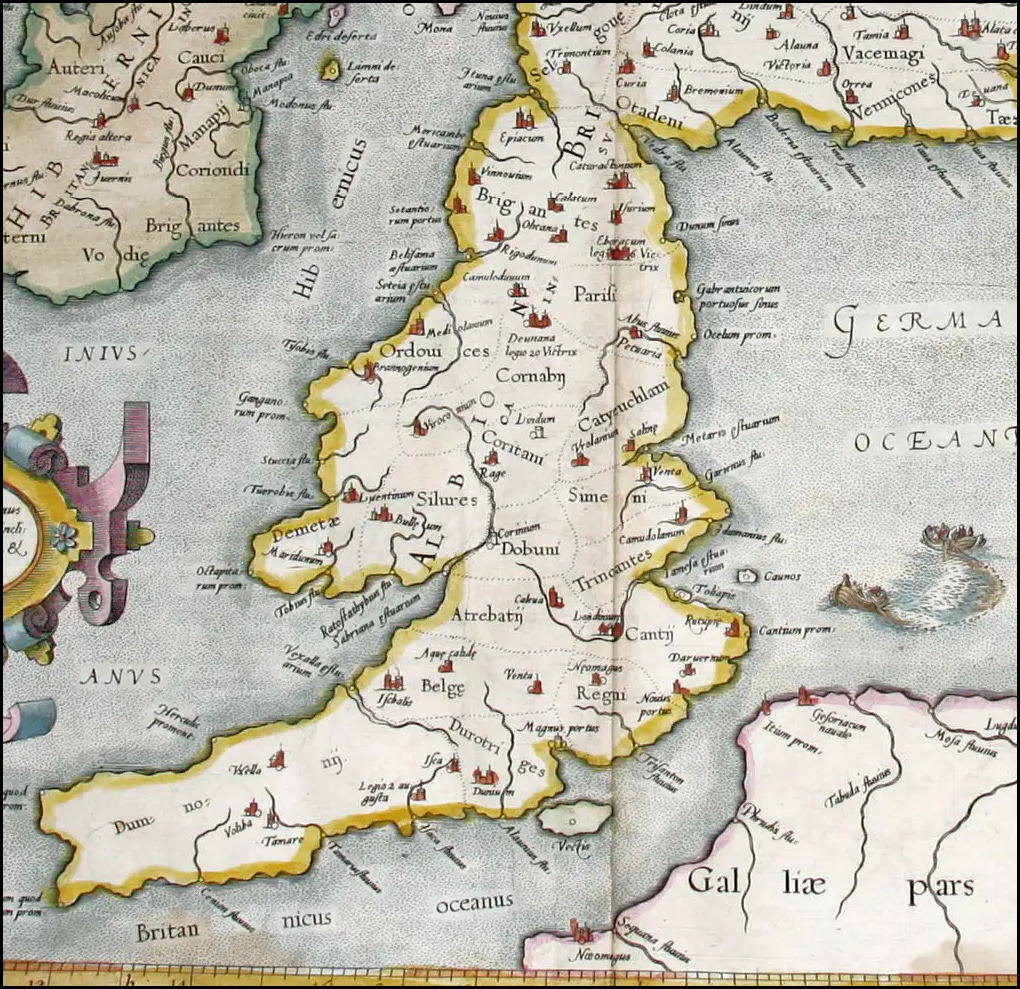
Image of Hibernia from Tabula Prima d'Europa, 1482AD
| | |
|---|
| Background to Claudius Ptolemy’s Geographia ▲ |
|---|
The Geographia is the first known description of locations known by the Romans, this appears to have been compiled by
Claudius Ptolemy of Alexandria in about 150AD. The text covers Europe, Africa and Asia showing that the Romans knew a
high percentage of the Northern Hemisphere in which are shown towns, rivers and peninsulas'.
It is very likely that the text was produced for the Roman Military, and was also for identifying trading routes, and
that the map was based on earlier maps, possibly by Marinus of Tyre or maybe earlier by the Carthaginians.
Ptolemy's work probably originally came with maps, but none have been discovered. Instead, the present form of the map
was reconstructed from Ptolemy's coordinates by Byzantine monks under the direction of Maximus Planudes shortly after
1295AD.
The illustration below is the map produced by Ruysch in 1508AD, and graphically illustrates the extent of the text and
the knowledge of the Romans from that period and was based on plotting the latitude and longitudes given in the text
onto the world map.
| 
Extract from Wikipedia
The Geography (Ancient Greek: Γεωγραφικὴ Ὑφήγησις, Geōgraphikḕ Hyphḗgēsis, lit.
"Geographical Guidance"), also known by its Latin names as the Geographia and the Cosmographia, is a gazetteer, an
atlas, and a treatise on cartography, compiling the geographical knowledge of the 2nd-century Roman Empire.
Originally written by Claudius Ptolemy in Greek at Alexandria around 150 AD, the work was a revision of a now-lost atlas
by Marinus of Tyre using additional Roman and Persian gazetteers and new principles.[1] Its translation – Kitab Surat
al-Ard – into Arabic by Al-Khwarismi in the 9th century was highly influential on the geographical knowledge and
cartographic traditions of the Islamic world.
| | Ptolemy Data Format ▲ |
|---|
The first thing to notice about the Ptolemy data is that the decimal points after the main number go to a maximum of .55
so it would seem logical to assume that each East/West segment was divided into six. Hence a section between 58 and 59
North and 10 to 11 East would consist of a 6 x 6 matrix (36 individual points) to provide granular accuracy, and if the
entry went to .05 would allow even finer granularity (144 individual points).
However it would also seem that if a whole number with no decimal places is shown for example 11 East, that it could
either be along the 11 line, or somewhere between 11 and 12 implying that the accuracy was not as good.
Summary:
If a number is displayed with a .05 accuracy it would probably mean that they were more confident of the data, if .1
then less so and finally if both were whole numbers then even less so.
This would mean in turn that the locations we should assume are the most accurate are those containing .05 entries,
followed by those with .1 finally whole numbers.
| | Analysis by other parties (Bill Thayer) ▲ |
|---|
There are a number of other people who have been interested in this subject and have tried analysing Ptolemy’s data
with differing ways of plotting the variance between his data and current maps.
The very first of these modern plots that I have found in the early 2000’s was created by Bill Thayer in his massive
LacusCurtius
website, which I show below.
| 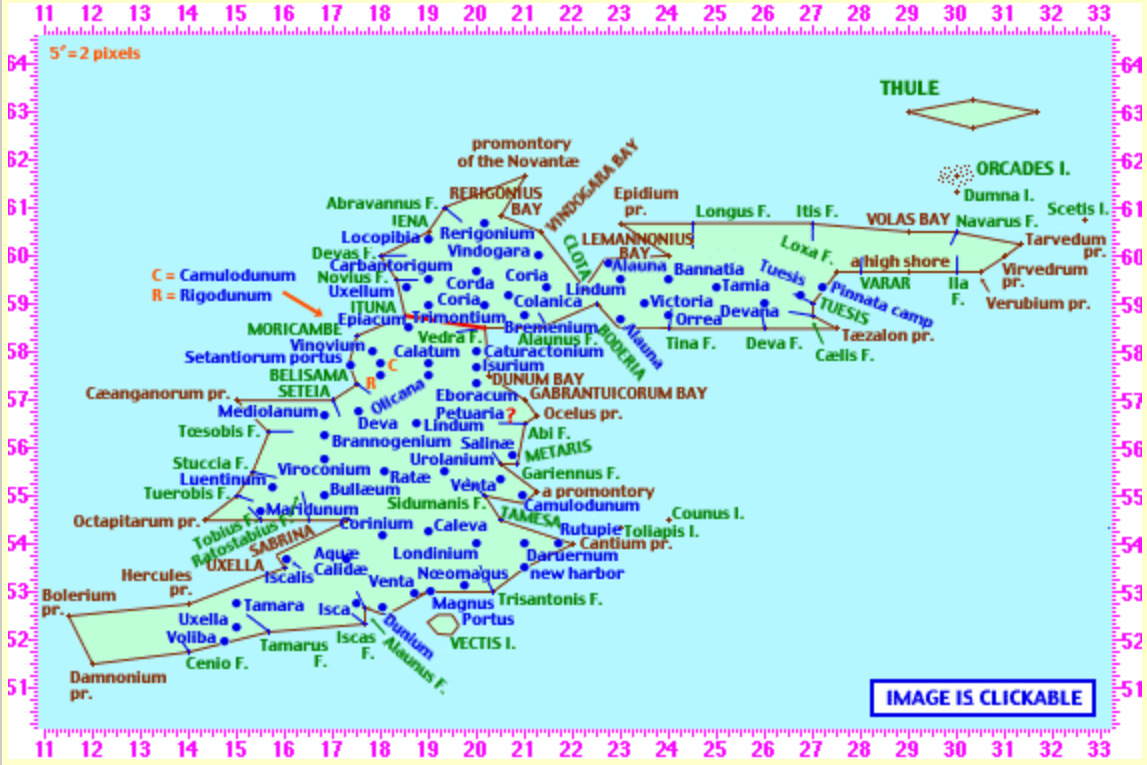
Bill plotted a number of maps from the Geographia, but decided that they were not particularly productive as most show
significant differences from the real world, implying that this was too time consuming and not very useful for others
looking at this subject.
The theory was that Ptolemy plotted real world latitudes and longitudes and these could be directly mapped.
| | My Analysis ▲ |
|---|
So it looks like plotting the latitude and longitudes directly onto the map is a waste of time, so lets plot the known
places onto a map and then analyse in reverse. This may prove difficult as a number of Ptolemy’s locations are not
easily identifiable, but we will give it a try and Albion has many data points, which makes the analysis more complex.
| 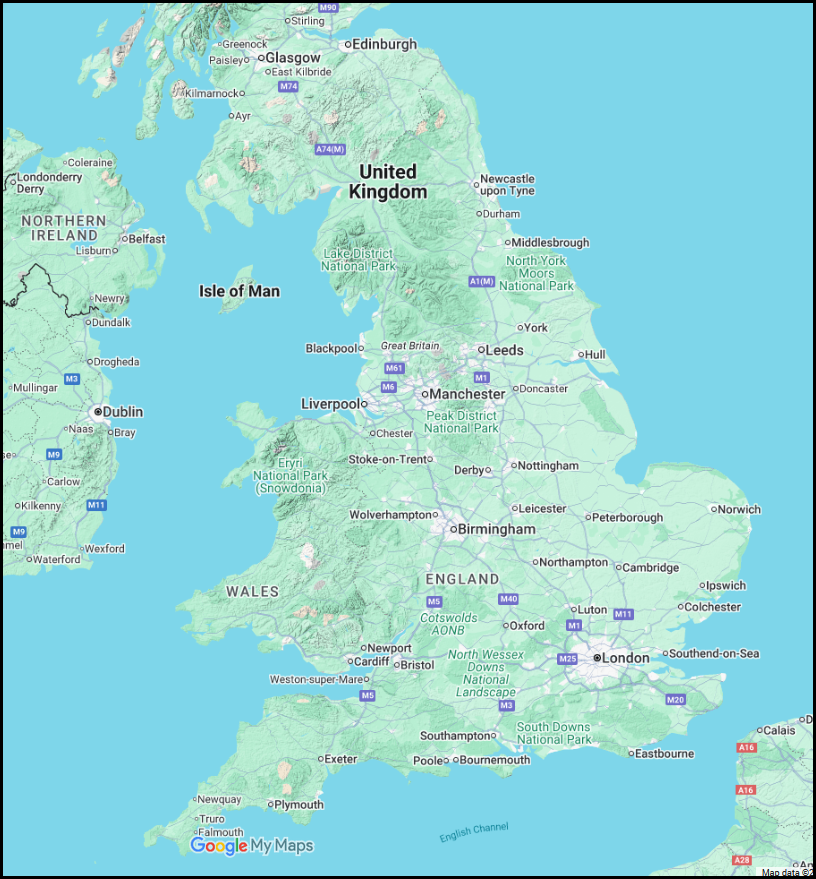
This is the modern map of Albion (England and Wales) from Google My Maps
| | Ptolemy Raw Data ▲ |
|---|
The following are the locations quoted by Ptolemy for Albion, I have excluded those for Scotland as these appear to need
a serparate analysis.
Please note: the red latitude longitude pairs are my suggested corrections after plotting on my last map.
A description of the northern coast, above which is the Duecaledonius ocean. |
| Novantarum peninsula, and promontory of the same name | 21*00 | 61°40(Mull of
Galloway) |
|---|
| Rerigonius bay | 20*30 | 60°50(Loch ryan) |
|---|
| Vindogara bay | 21*20 | 60°30(Irvine bay) |
|---|
| Clota estuary | 22*15 | 59°20(Firth of Clyde) |
|---|
| Lemannonius bay | 24*00 | 60°00(Near Prestwick) |
|---|
| Epidium promontory | 23*00 | 60°40(Mull of Kintyre) |
|---|
| mouth of the Longus river | 24*30 | 60°40(Loch Linnhe) |
|---|
| mouth of the Itis river | 27*00 | 60°40(Loch Ewe) |
|---|
| Volas bay | 29*00 | 60°30(Loch Eriboll) |
|---|
| mouth of the Navarus river | 30*00 | 60°30(River naver) |
|---|
| Tarvedum or Orcas promontory | 31*20 | 60°15(dunnet head) |
|---|
Description of the west a side which borders on the Hibernian ocean and the Vergionius
ocean. |
| From the Novantian promontory | 21*00 | 61°40(Mull of Galloway) |
|---|
| mouth of the Abravannus river | 19*20 | 61°00(Gillespie Burn) |
|---|
| Iena estuary | 19*00 | 60°30(River Cree) |
|---|
| mouth of the Devas river | 18*00 | 60°00(River Dee) |
|---|
| mouth of the Novius river | 18*20 | 59°30(River Nith) |
|---|
| Ituna estuary | 18*30 | 58°45(Solway Firth) |
|---|
| Moricambe estuary | 17*30 | 58°20(morcambe bay) |
|---|
| Setantiorum harbor b | 17*20 | 57°45(Skipool - Fleetwood) |
|---|
| Belisama estuary | 17*30 | 57°20(river ribble) |
|---|
| Seteia estuary | 17*00 | 57°00(river mersey) |
|---|
| Caeanganorum promontory | 15*00 | 57°00(Great Orme) |
|---|
| mouth of the Toesobis river | 15*40 | 56°20(Tremadog Bay) |
|---|
| mouth of the Stuccia river | 15*20 | 55°30(Afon Dyfi) |
|---|
| mouth of the Tuerobis river | 15*00 | 55°00(Afon Ystwyth) |
|---|
| Octapitarum promontory | 14*20 | 54°30(St Davids Head) |
|---|
| mouth of the Tobius river | 15*30 | 54°30(River Loughor) |
|---|
| mouth of the Ratostabius river | 16*30 | 54°30(River Usk) |
|---|
| Sabrina estuary | 17*20 | 54°30(River Severn) |
|---|
| Uxella estuary | 16*00 | 53°30(River Axe) |
|---|
| Herculis promontory | 14*00 | 52°45(Hartland point) |
|---|
| Antivestaeum or Bolerium promontory | 11*30 | 52°30(Lands End) |
|---|
| Damnonium or Ocrium promontory | 12*00 | 51°30(Lizard Point) |
|---|
Description of the south side below which is the Britannic ocean. After the Ocrium promontory
is |
| the mouth of the Cenio river | 14*51 | 51°45(River Fal or Fowey) |
|---|
| mouth of the Tamarus river | 15*40 | 52°10(River Tamar) |
|---|
| mouth of the Iscas river | 17*40 | 52°20(River Exe) |
|---|
| mouth of the Alaunus river | 17*40 | 52°40(River Axe) |
|---|
| Magnus Portus | 19*00 | 53°00(Portchester) |
|---|
| mouth of the Trisantonis river | 20*20 | 53°00(River Arun) |
|---|
| New harbor | 21*00 | 53°30(Pevensey) |
|---|
| Cantium promontory | 22*00 | 54°00(South Foreland) |
|---|
A description of the eastern and the southern side next to which is the Germanic ocean. After the
Tarvedum promontory, or Orcades, by which it is known, |
| Virvedrum promontory | 31*00 | 60°00(Duncansby Head) |
|---|
| Verubium promontory | 30*30 | 59°40(Noss Head) |
|---|
| mouth of the Ila river | 30*00 | 59°40(River Helmsdale) |
|---|
| a high shore | 29*00 | 59°40(Balintore) |
|---|
| Varar estuary | 28*00 e | 59°40(Beauly Firth) |
|---|
| mouth of the Loxa river | 27*30 | 59°40(River Lossie) |
|---|
| Tuesis estuary | 27*00 | 59°00(River Spey) |
|---|
| mouth of the Caelis river | 27*00 | 58°45(River Deveron) |
|---|
| Taezalon promontory | 27*30 | 58°30(Kinnairds Head) |
|---|
| mouth of the Deva river | 26*00 | 58°30(River Dee) |
|---|
| mouth of the Tina river | 24*00 | 58°30(River tay) |
|---|
| Boderia estuary | 22*30 | 59°00(Firth of Forth) |
|---|
| mouth of the Alaunus river | 21*20 | 58°30(River Aln) |
|---|
| mouth of the Vedra river | 20*10 | 58°30(River Wear) |
|---|
| Dunum bay | 20*15 | 57°30(Tees Bay) |
|---|
| Gabrantuicorum bay with many harbors | 21*00 | 57°00(South of Flamborough
head) |
|---|
| Ocelus promontory | 21*15 | 56°40(near withernsea) |
|---|
| mouth of the Abi river | 21*00 | 56°30(The Humber) |
|---|
| Metaris estuary | 20*30 | 55°40(The Wash) |
|---|
| mouth of the Gariennus river | 20*50 | 55°40(River Yare) |
|---|
| A promontory | 21*15 | 55°05(Felixstowe) |
|---|
| mouth of the Sidumanis river | 20*10 | 55°00(river colne) |
|---|
| Tamesa estuary | 20*30 | 54°30(Thames) |
|---|
| Next to this the Cantium promontory | 22*00 | 54°00(South Foreland) |
|---|
The Novantae dwell on the side toward the north below the peninsula of this name, among whom are
the following towns: |
| Locopibia | 19*00 | 19*00(?) |
|---|
| Rerigonium | 20*10 | 20*10(?) |
|---|
Below are the Selgovae, among whom are the following towns: |
| Carbantorigum | 19*00 | 19*00(?) |
|---|
| Uxellum | 18*30 | 18*30(?) |
|---|
| Corda | 20*00 | 20*00(?) |
|---|
| Trimontium | 19*00 | 59°00(Newstead) |
|---|
From these toward the east, but more northerly, are the Damnoni, among whom are the following
towns: |
| Colanica | 20*45 | 20*45(?) |
|---|
| Vindogara | 21*20 | 21*20(?) |
|---|
| Coria | 21*30 | 21*30(?) |
|---|
| Alauna | 22*45 | 22*45(?) |
|---|
| Lindum | 23*00 | 23*00(?) |
|---|
| Victoria | 23*30 | 23*30(?) |
|---|
Further south are the Otalini, among whom are the following towns: |
| Corstopitum | 20*10 | 20*10(corbridge?) |
|---|
| Alauna | 23*00 | 23*00(Learchild ?) |
|---|
| Bremenium | 21*00 | 58°45(High Rochester) |
|---|
Next to the Damnoni, but more toward the east near the Epidium promontory are the Epidi and next
to these the Cerones; then the Carnonacae, and the Caereni but more toward the east; and in the extreme east dwell the
Cornavi; from the Lemannonis bay as far as the Varar estuary are the Caledoni, and above these is the Caledonian forest,
from which toward the east are the Decantae, and next to these the Lugi extending to the Cornavi boundary, and above the
Lugi are the Smertae; below Caledonia are the Vacomagi, among whom are the following towns: |
| Bannatia | 24*00 | 24*00(?) |
|---|
| Tamia | 25*00 | 25*00(?) |
|---|
| Pinnata camp | 27*15 | 59°20(Tayside) |
|---|
| Tuesis | 26*45 | 26*45(?) |
|---|
Below these toward the west are the Venicones, whose town is |
| Orrea | 24*00 | 58°45(Carpow) |
|---|
More toward the east are the Taezali |
| and the town Devana | 26*00 | 59°00(Chester) |
|---|
Below the Selgovae and Otalini f are the Brigantes extending to both seas, among whom are the
following towns: |
| Epiacum | 18*30 | 58°30(Whitley Castle) |
|---|
| Vinovium | 17*45 | 58°00(Binchester) |
|---|
| Caturactonium | 20*00 | 58°00(Catterick) |
|---|
| Calatum | 19*00 | 19*00(?) |
|---|
| Isurium | 20*00 | 57°40(Aldborough) |
|---|
| Rigodunum | 18*00 | 18*00(?) |
|---|
| Olicana | 19*00 | 19*00(?) |
|---|
| Eboracum, Legio VI Victrix | 20*00 | 57°20(York) |
|---|
Near which on the Opportunum bay are the Parisi and the town |
| Petuaria | 20*40 | 56°40 g (Brough on Humber) |
|---|
Below these are the Brigantes but some distance toward the west are the Ordovices, among whom are
the towns: |
| Mediolanum | 16*45 | 16*45(?) |
|---|
| Brannogenium | 16*45 | 56°15(Leintwardine) |
|---|
From these toward the east are the Cornavi, among whom are the towns: |
| Deva, Legio XX Victrix | 17*30 | 56°45(Chester) |
|---|
| Viroconium | 16*45 | 55°45(Wroxeter) |
|---|
Next to these are the Coritani, among whom are the towns: |
| Lindum | 18*40 | 56°30(Lincoln) |
|---|
| Ratae | 18*00 | 55°30(Leicester) |
|---|
Next are the Catuvellauni, among whom are the towns: |
| Salinae | 20*45 | 20*45(?) |
|---|
| Urolanium | 19*20 | 55°30(St Albans) |
|---|
Next to these are the Iceni, |
Farther eastward and near the estuary of the Tamesa are the Trinovantes |
| and the town Camulodunum | 21*00 | 55°00(Colchester) |
|---|
Below the peoples we have mentioned, but more toward the west are the Demetae, whose towns
are: |
| Luentinum | 15*45 | 55°10(Pumsaint) |
|---|
| Maridunum | 15*30 | 54°40(Carmarthen) |
|---|
More toward the east are the Silures |
| whose town is Bullaeum | 16*50 | 55°00(Usk) |
|---|
Next to these are the Dobuni, |
| and their town Corinium | 18*00 | 54°10(Cirencester) |
|---|
then the Atrebati |
| and their town Caleva | 19*00 | 54°15(Silchester) |
|---|
Next to these, but farther eastward, are the Canti among whom are the towns: |
| Londinium | 20*00 | 54°00(London) |
|---|
| Daruernum | 21*00 | 54°00(Canterbury) |
|---|
| Rutupie | 21*45 | 54°00(Richborough) |
|---|
Below the Atrebati and the Canti are the Regni and the town |
| Noeomagus | 19*45 | 53°05(Chichester) |
|---|
Below the Dobuni are the Belgae and the towns: |
| Iscalis | 16*00 | 53°40(Dowsborough hill fort) |
|---|
| Aquae calidae | 17*20 | 53°40(Bath) |
|---|
| Venta | 18*40 | 53°00(Winchester) |
|---|
Toward the west and south of these are the Durotriges whose town is |
| Dunium | 18*00 | 52°40(Hods hill) |
|---|
Next to these, but more to the west, are the Dumnoni, whose towns are: |
| Voliba | 14*45 | 52°00(Castle an Dinas) |
|---|
| Uxella | 15*00 | 52°45(Launceston) |
|---|
| Tamara | 15*00 | 52°15(Plymouth) |
|---|
| Isca, where is located Legio II Augusta | 17*30 | 52°45(Exeter) |
|---|
The islands which are near Albion island and the Orcades promontory are: |
| Scetis island | 32*40 | 60°45(Skye) |
|---|
Eastward from the Trinovantes region there are two islands: |
Below Magnus Portus is the island Vectis, |
| the middle of which is in | 19*20 | 52°20(Blackwater) |
|---|
Above these islands are the Orcades, about thirty in number, |
| the middle of which is in | 30*00 | 61°40(Orkney) |
|---|
|
Map of England and Wales showing Ptolemy Latitude lines ▲
|
|---|
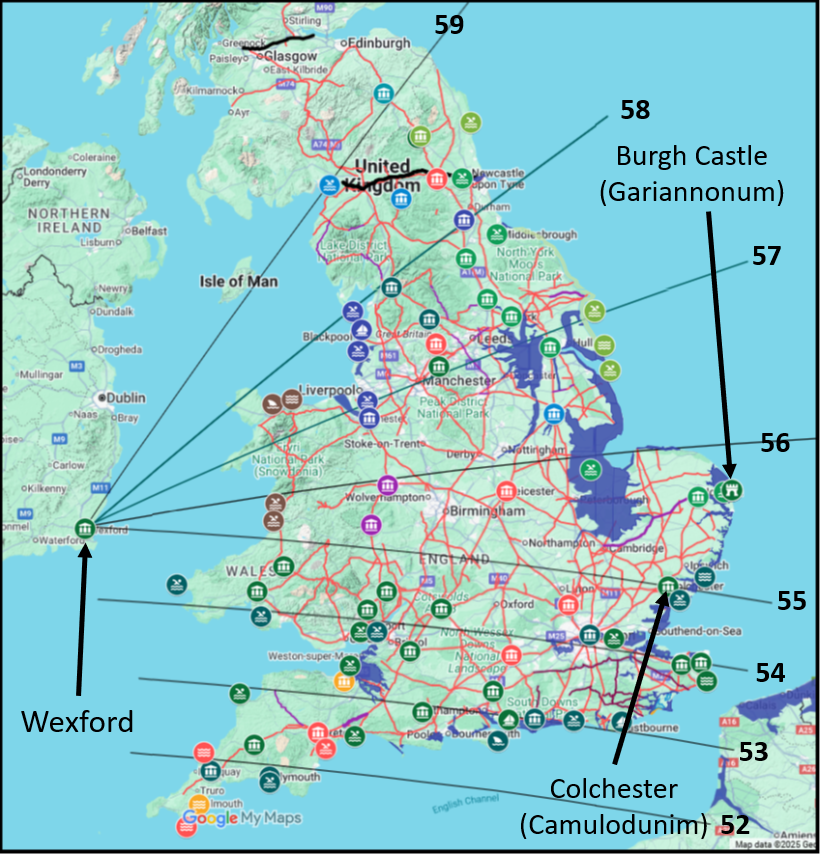
This map shows the location of the degrees north lines based on a Google My map.
In this map I have grouped all those places together with the same whole latitude numbers, an exaple of these are all
those with 54 degrees in their latitude, which consist of Richborough, Canterbury,Thames Estuary, London, Cirencester,
Usk, Whitchurch, Caermarthen, Pumsaint and St David's point.
As you can see, the ones for the South of England show an angling down towards the South of Spain, but once you get
above Norfolk the lines appear to be connected to Wexford in Eire(Southern Ireland), and rotate as the locations carry
on northwards.
This is fairly odd behavior for a map, but if this is correct then it seems to imply that the Roman navy mostly
collected the location data, and then calculated the positions from known fixed locations.
So lets look at the South of England first:
|
South of England and the Longitude(East West) lines ▲
|
|---|
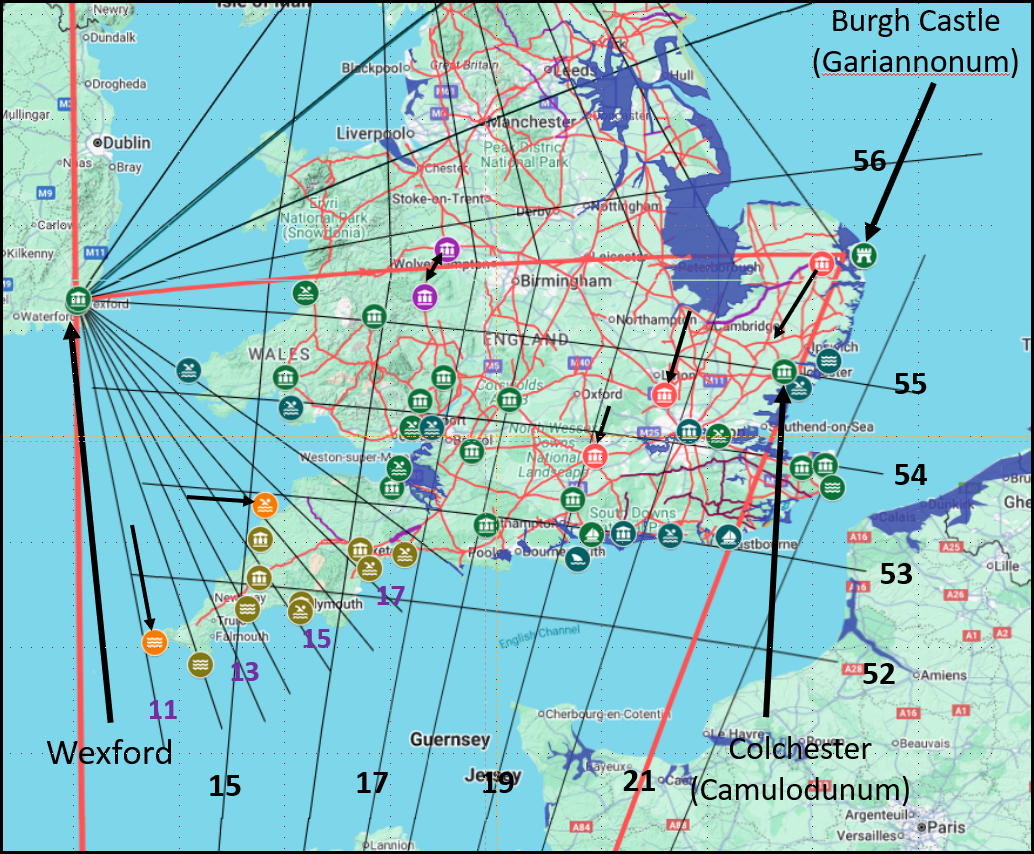
This map shows the location of the degrees east lines based on a Google My map.
In this map I have grouped all those places together with the same whole longitude numbers, an example of these are all
those with 15 degrees in their longitude, which consist of the river Tamar, Plymouth, Launceston, Hartland point, river
Towy, Caermarthen and Pumsaint.
The locations shown in green appear to be accurate according to my logic.
The places shown in red appear to have incorrect latitudes and longitudes these include Venta Incinorum which looks like
it was probably Bury St Edmunds not Caistor st Edmund, it would seem likely that the Romans knew the exact location of
Colchester(Camulodunum), so Venta Icingorum would be accurately measured.
Other red places are Silchester, this is inland and appears to be a small distance south of Ptholemy's locations. This
seems to imply that the Roman navy did the mapping as the coastline appears to be more accurate than inland locations.
The whole of Devon and Cornwall longitudes appear to be measured from Wexford again - dark green are in the correct
place, the purple numbers show the longitude if calculated from Wexford. The orange ones are not in the correct place,
Hartland point is about 2 degrees longitude out and Lands End about 1 degree latitude.
Those in purple appear to have their details transposed these are Mediolanum and Brannogenium.
Please note:
I have noticed a number of places that are 1 degree of latitude or longitude away from where they should be but
this could be a translation fault, or a transcription mistake so please do not expect the Roman locations to be as
accurate as our modern ones.
There is also the possibility that the name changed during the Roman era, or that we(collectively) have not located the
place correctly, or that two roman place names have been transposed. (This last possibility seems to have taken place
with the Ordovices towns Viroconium [we know it as Wroxeter] and Brannogenium [we know it at Leintwardine] would look
better if they were transposed - shown in purple on the maps).
|
North of England and the Longitude(East West) lines ▲
|
|---|
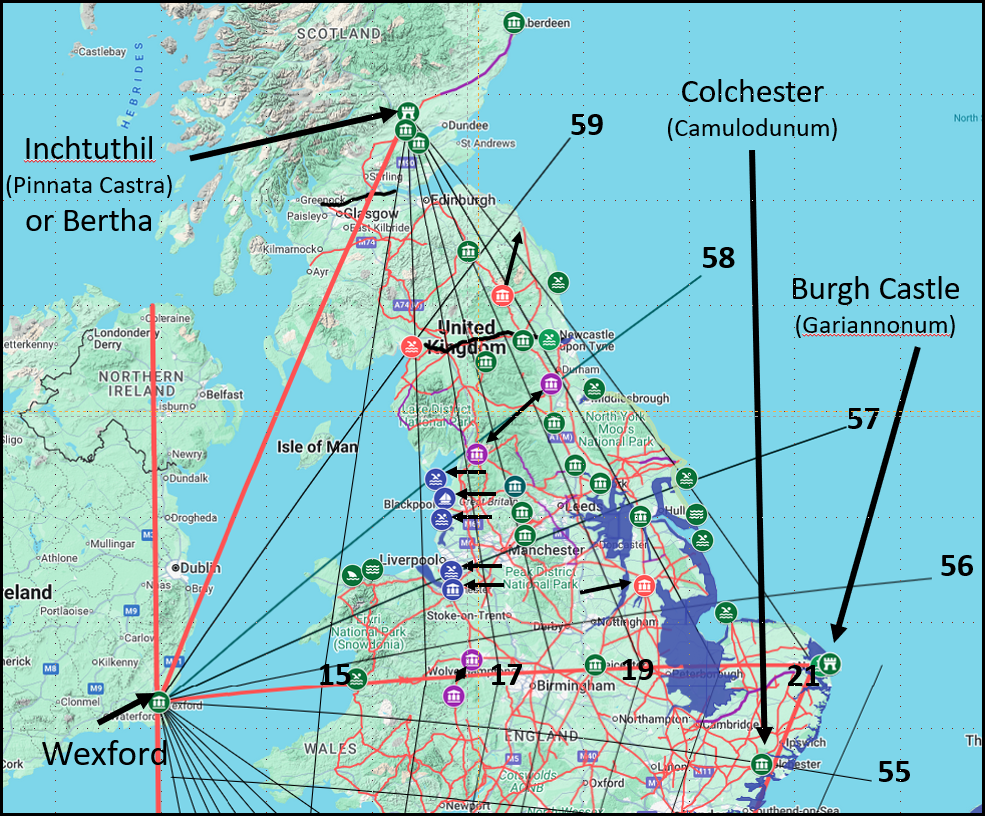
The longitude lines for the North of England continue from what appears to be a break line between Wexford and Burgh
Castle in Norfolk. The lines continue north to a point either at Pinnata Castra(Inchtutil Fort) or at a possible naval
base at Bertha just south of Inchtutil.
The majority of the locations appear to be in the correct alignment, with the exception of Chester and the coast to the
north to Morecambe bay which all appear to be recorded 1 degree to the east further than expected.(the points marked in
dark blue)
The two purple locations in the north are 58.00 17.45 Vinovium(Binchester) and 57.45 19.00 Calatum(Burrow in Lonsdale)
and appear to have the lat/long pairs swapped.
The red location at the top of the map is 58.45 21.00 Bremenium(High Rochester) but this item appears to be mapped to
Berwick upon Tweed.
As with the southern map there are a few places which seem to be out of place, but these could be mistyping, or modern
historians giving the places the wrong Roman names.
| | Conclusion ▲ |
|---|
So from the above analysis and that from Hibernia it would seem that Ptolemy used
fixed points to calculate the latitude and longitude.
,br>
Wexford or nearby in Southern Ireland appears to be a major mapping point for Hibernia and the North of Albion(England
and Wales) that implies a Roman naval base in the area.
These appear to be coastal points, implying that the Navy was doing the main mapping, these include Gades(Cadiz),
Wexford in Ireland .
|
|
|
|
|
|
| |
|
|
Local Interest
Just click an image |
|
|
|
|
|
|
|
|
|
|
|
|
| |
|
|